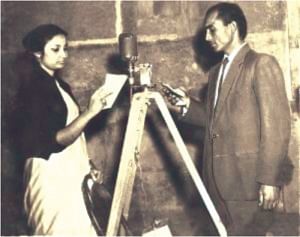| Home - Back Issues - The Team - Contact Us |
 |
| Volume 10 |Issue 35 | September 16, 2011 | |
|
|
Entertainment The Radio Revival Farhana Urmee
In the late 60s the radio was the prime source of entertainment for people. Recalling the old times two sisters-Tahmina Yasmin (52) and Khaleda Edib (55) recall the time when they would finish their household chores and study in a hurry, inviting cousins in the neighbourhood to join in an activity that would be the highlight of the day: listening to the much awaited Onurodher Ashor. The programmes played the songs requested by listeners from all over the country. Listeners, at that time, could request a song of their choice by mailing. Stirring the memories Tahmina and Khaleda said of the programmes broadcast by the station they liked musical programmes which played their favourite songs from films. For Tahmina Onurodher Ashor was the most desirable as it would often play requests from listeners and it was always a big thrill to hear the presenter mention her name and then play her favourite song. Those days disappeared with the advent of television which totally obliterated the charm of the radio. Tahmina and Khaleda's first black and white TV set made them abandon their radio set and later, the coloured television set finished the job of making them forget their radio days completely. Soon the VCR and satellite television channels would add to the list of entertainment options, leaving the radio to gather dust in the corner. Bangladesh Betar, the country's state-owned radio went through a decline and existed only for the sake of existing with little innovation or development. It was in 2006 that Radio Today, the first private FM radio station in Bangladesh set a new trend in the world of information and entertainment. With a completely new and refreshing format the station won the hearts of millions of listeners many of whom never listened to radio before. Other radio stations –Radio Aamar, Radio Foorti and ABC Radio- successfully followed the footsteps of Radio Today. Regarding the huge acceptance of FM radio stations Md Monir Uzzaman, General Manager, Radio Today says that there are a number of reasons behind the large scale acceptance of radio in this age of advanced communication technology. Radio is always a cheaper and accessible medium but the growth and availability of visual medium more or less left this powerful instrument of communication behind. Again, the very type of one-way communication operated by Bangladesh Betar, the state radio station held back the potential of the particular medium, Monir observes. “We had the principle to make the communication two-way and to give a priority to our listeners' demand. That really worked in our success”, says Monir adding that, primarily there is a tendency to assume that these stations represent young listeners' only. "But we target out listeners very carefully involving all age groups and design the programmes accordingly" he says.
Another reason for FM radio's popularity might be its 'CD sound' quality. Generally, the standard of sound quality has three scales: telephone quality, radio quality and CD quality. The commercial FM radio stations in Bangladesh operate in CD quality sound, which is a key factor for its wide acceptance. Monir thinks that in today's hectic life it is hard to manage a good time to sit before television or go to movies daily, where radio is not taking any extra time from one's day and one can also listen to it easily while remaining busy in other activities. Moreover, no extra device is required nowadays to be a radio listener as radio can be tuned in from a regular cellular phone and one can listen to radio while travelling by cars. “When we were about to start the radio stations people discouraged us, as the idea of infotainment was dominated by visual medium, especially television”, says Monir. But the response was good from the very beginning and increasing demand from the listeners' side is inspiring us to open more stations countrywide. “Initially we had stations in Dhaka, Chittagong and Cox's Bazaar, and now it has been expanded to stations in Bogra, Sylhet, Khulna. We are going to install a total of ten stations, of them two are in waiting for approval from the government”, Monir adds. Of the FM radio stations in the country the only Dhaka-based FM broadcasters are Radio Aamar and ABC radio and Radio Foorti is also expanding its network countrywide. “Currently we cover two thirds of the country and different surveys indicate that the number of listeners is increasing”, Monir adds further. FM radio stations are conducting research to know their listeners taste and demand and thus scheduling their programmes and segments accordingly. Rakib, a university student was not really fond of radio. To him most of the stations were over dependent on musical programmes. But when Radio Foorti started to broadcast a programme titled as Bhoot FM at Friday 12 am, Rakib stays awake to listen to the real life ghost experience of people shared in the particular programme. Again, another programme called Aamar Bhalobasha has made Rakib a real fan of today's radio stations. It is broadcast in Radio Aamar where representative from common listeners are given a chance to share their stories of love and relationship for two hours with the rest of the audience. Monir also says on the interactive dimension of FM radio stations which has made them so popular. “When listeners see that the stations really care about their tastes their interest in radio will increase.Not only the entertainment based programme, but also frequent news bulletins get a massive response from our listeners. Again, traffic updates and market situation updates are segments which have been proved to be very useful to our listeners”, adds Monir. With the advancement of technology FM radio stations would be able to reach their listeners with the ultimate infotainment package and scope of interaction as well. The story of Tahmina and Khaleda might have been on pause for sometime but it does not have to end as they can see their grand daughters sending text messages to their favourite RJs to play a song and becoming thrilled when it is played just like the good old days.
Copyright (R) thedailystar.net 2011 |

